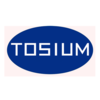22MnB5鋼奧氏體化時熱鍍Al-10wt%Si鍍層組織結構的演化22MnB5鋼奧氏體化時熱鍍Al-10wt%Si鍍層組織結構的演化Microstructure evolution of hot-dip Al-10wt%Si coating during 22MnB5 hot formed steel austenitizing 用SEM觀察了22MnB5鋼在900 ℃不同奧氏體化時間下,熱鍍Al-10wt%Si鍍層的微觀組織結構變化情況,用EDS和GD-OES分析了奧氏體化后熱鍍Al-10wt%Si鍍層的元素分布。結果表明,22MnB5鋼奧氏體化前,熱鍍Al-10wt%Si鍍層主要由純鋁相、純硅相和二者共晶反應形成的金屬間化合物Fe2SiAl7相組成,在Fe2SiAl7相和鋼基體之間存在一層薄薄的Fe2Al5相和FeAl3相組成的化合物層。900 ℃奧氏體化時,熱鍍Al-10wt%Si鍍層中的三元共晶相Al+Si+τ6逐漸轉變為三元Al-Fe-Si或二元Fe-Al金屬間化合物。奧氏體化時間2 min時,鍍層主要由Fe2SiAl7相、Fe2Al5相和FeAl2相組成;奧氏體化時間5 min時,鍍層主要由FeAl2相、Fe2SiAl2相和Fe5SiAl4組成;奧氏體化時間8 min時,鍍層主要由FeAl2相和Fe5SiAl4組成。由于Fe2SiAl2相和鍍層/鋼基體界面擴散層中Al原子的擴散系數遠大于Fe原子,導致從鍍層向鋼基體晶界及晶粒內擴散并與之反應所消耗Al原子的量遠大于從鋼基體擴散到鍍層中的Fe原子量,從鋼基體中流入到鍍層中的空位數量遠大于從鍍層中流入到鋼基體中的空位數量。原子的不平衡擴散及鍍層/鋼基體界面空位數量的富余使得擴散反應層與鍍層的交界區域形成了Kirkendall孔洞。22MnB5鋼奧氏體化時,熱鍍Al-10wt%Si鍍層表面形成一層穩定的Al2O3氧化膜,鍍層的熱氧化現象非常有限,熱鍍Al-10wt%Si鍍層可以作為22MnB5鋼熱成形時的保護層。但熱鍍Al-10wt%Si鍍層擴散過程中產生的脆性金屬間化合物相因高溫塑性不足而導致鍍層中產生大量垂直于鍍層/鋼基體界面并貫穿整個鍍層的微裂紋,而影響鍍層的防護性能。 The thermo-mechanically induced microstructure change of hot-dip Al-10wt%Si coating was observed by scanning electron microscopy for different austenitizing time at 900 ℃ after 22MnB5 hot formed steel austenitizing, and the elemental depth profiles in hot-dip Al-10wt%Si coating was analyzed by Energy Dispersive Spectroscopy (EDS) and Glow Discharge Optical Emission Spectrometry (GDOES) after austenitizing. The results show that before 22MnB5 hot formed steel austenitizing, the hot-dip Al-10wt%Si coating consisted mainly of an aluminum matrix, pure silicon phase, and the intermetallic phase Fe2SiAl7, which was formed by eutectic reaction, and there was a thin layer which was composed by Fe2Al5 phase and FeAl3 phase, between the intermetallic phase Fe2SiAl7 and the steel substrate. When 22MnB5 hot formed steel was austenitized at 900 ℃, the ternary eutectic phase Al+Si+τ6 would be transformed into Al-Fe-Si ternary intermetallic compound or Fe-Al binary intermetallic compound gradually in the hot-dip Al-10wt%Si coating. When the austenitizing time was 2 min, the Al-10wt%Si coating was composed by the intermetallic phase Fe2SiAl7, Fe2Al5 phase and FeAl2 phase mainly, when the austenitizing time was 5 min, the Al-10wt%Si coating was composed by FeAl2 phase, Fe2SiAl2 phase and Fe5SiAl4 phase mainly, when the austenitizing time was 8 min, the Al-10wt%Si coating was composed by FeAl2 phase and Fe5SiAl4 phase mainly. Because the diffusion coefficient of Al atom was much larger than that of Fe atom in the diffusion layer of intermetallic phase Fe2SiAl2 and coating/steel substrate, that result in consumed the amount of Al atoms which diffused and reacted from coating to the grain boundaries or grain of steel substrate was much larger than that of the Fe atoms which diffused from the steel substrate to the Al-10wt%Si coating, And the number of vacancies which diffused from the steel substrate to the Al-10wt%Si coating was much larger than that diffused from the Al-10wt%Si coating to the steel substrate. So the Kirkendall hole was formed in the interface between the diffusion reaction layer and the Al-10wt%Si the coating, due to the unbalanced diffusion of atoms between the Al-10wt%Si coating and the steel substrate and the abundance of vacancies in the interface of coating/substrate. When the 22MnB5 hot formed steel austenitizing, there was a stable Al2O3 film formed on the surface of Al-10wt%Si coating, and the thermal oxidation of the Al-10wt%Si coating was very limited, so the hot dip Al-10wt%Si coating could been used as the protective layer. But the protective performances of Al-10wt%Si coating could be poor, because the high temperature ductility of brittle intermetallic compound was low, which induce a lot of micro cracks that perpendicular to the interface of coating/steel substrate, and prong the whole coating, during the diffusion process of hot dip Al-10wt%Si coating. 全文下載:http://pan.baidu.com/s/1i500Mqx 上一篇: 國產核用不銹鋼輻照損傷研究
|







